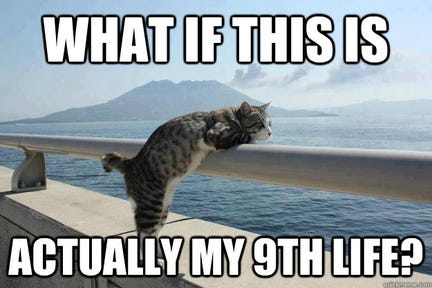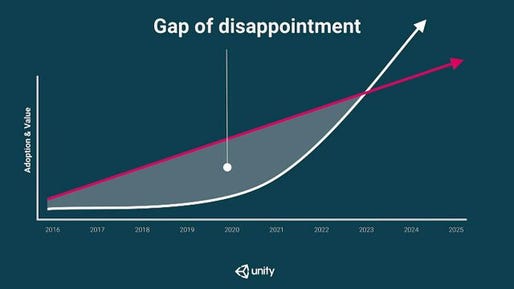
Featured Blog | This community-written post highlights the best of what the game industry has to offer. Read more like it on the Game Developer Blogs.
Latest VR Market Data, Let's Get Our Mojo Back
Revealing a new type of data, Schneider tests the top statements about VR's market growth expectations and highlights the Immersive Technology Alliance's latest effort to build the industry. Time to dust ourselves off, problem solve, get our Mojo back!


In this author's opinion, the virtual reality market is having a crisis of faith. It's struggling to come to grips with its limited sales, it is grasping on to the same hyped up reports promoting that we'll do better next decade, and I have yet to see a single projection giving a convincing explanation as to why the market is expected to grow. The closest exception is John Riccietello's often quoted Gap of Disappointment which I think is a far riskier proposition. We instead have a Gap of Suspended Reality when it's in our power to fix that - now.
In this piece, I'm going to share the latest data we have, I'll discuss why I think we are seeing the results that we are, and reveal a really cool effort to help overcome the presented challenges. The whole thing is very ambitious, and I figured it was important to explain how we got from point A to point B in our thinking so that the market is onside for everyone's benefit.
In December 2015, the alliance published virtual reality sales numbers for PC, mobile, and console for the first 12 months of launch for modern VR devices. They turned out to be solid, especially for PC and console. We also said that vendors could wait as long as a year to go seriously in on VR. The reason was that based on the available horsepower, we expected the total market sales would be capped at about 300,000 to 500,000 units give or take in the PC universe (HTC Vive, Oculus Rift, everything else PC). Yes, there are mobile and console numbers too, but they all tell the same story in their own way.
Fast forward to 2017, and what started with an estimated three million qualified virtual reality PCs last year (computers ready for a VR device) has grown to a new figure of 13 to 15 million qualified PCs. The reasons for this dramatic growth is Moore's Law and new software techniques making it possible to do more with less computer horsepower.

We should all be celebrating, right? You'd think.
Last December, I started a hunt to find evidence that the VR market is growing at the consumer level because I was hoping this would help me plot the market's progress to success. I researched how the virtual reality online communities were doing. I looked at Reddit, the traffic for the online discussion forums for key vendors, I regularly visited multiple metaverse platforms, I did secret shopping, and more. I continue to keep a close watch on things to this day. What I found was mind boggling.

Look carefully at the "Gap of Disappointment" growth curves.


We need to work for better growth, even for "Gap of Disappointment" standards.
Reddit has the largest online VR communities that I know of. These graphs highlight the subscription level of each VR Reddit community and when they hit certain membership milestones. Remember that Reddit accounts last forever, so the numbers never go down. In the case of Oculus, they have been in a state of plateau for over a year. HTC has grown since the start, and they suddenly hit their plateau in March of this year. I hypothesize that the Oculus community just jumped over to the Vive community, and we are dealing with the same people. There is other data too; it all works out the same way.

Here is the scary part. If the VR hardware prices are dropping and the computer horsepower pricing is dropping, where is the measurable increase in sales or online activity? Why are we seeing these trends?
The first variable that everyone touts as the solution is content. We need more blessed VR content! While I'm sure content will help, I am not yet seeing evidence that this is dramatically changing the trend yet. Insomniac Games' Unspoken was released last November. Epic Games' Robo Recall was released on March 1st. Owlchemy Labs' Rick and Morty was released in April. No effect.
There are AAA games coming down the pipe like Fallout 4 in VR and Star Trek: Bridge Crew; I'm sure the best is yet to come for our VR softare libraries. The question is whether that content will live in our existing universe, or will it stretch outward and expand the audience? It could go either way, and so far the evidence tells me it's a gamble to be dependent on this alone.

Could it be standards? It's public knowledge that the Khronos Group is actively working on open standards pertaining to immersive technology, and I fully support them. Still, standards alone wouldn't dramatically affect these trend lines given the limited sales numbers all around.
Is it price? In the PC world, the former top tier graphics cards are now mid-range, and the pricing has been dropping for the VR HMDs. This, and there is a slew of mixed reality devices coming to market from a myriad of suppliers. If we look at the highly-invested hardcore gamers, that market has every ability to put money in the VR space. I'm unconvinced that price is dramatically impacting the growth curves; especially when we figure that there is a customer base that is content to spend money on things like this.

Source: The Simpsons, Fox
Is it wildly unrealistic expectations? Not exactly. When Facebook acquired Oculus for X billion dollars, they inadvertently defined a yardstick before the market could get its facts and figures straight. So sure, we have our "Gap of Disappointment". However, even if the most realistic expectations were in place, we should be seeing measurable growth and be able to explain why we are seeing that growth. I'm unable to find evidence that the gap curve is working in this case.

Are we crazy to think that people will wear an electric Kleenex box on their face? Maybe in public...or on a bus, or while piloting an airplane. I think people will agree to do all kinds of things if the value is delivered to them and it's reasonably comfortable to do so. Even if VR is geared to a subset of users, there should be plenty of room for growth.
Source: This is Spinal Tap
Is it that dreaded screen door effect? Resolution? Motion sickness? Locomotion? Spontaneous combustion? Maybe, though I think it's unlikely that content makers of all sizes would get so excited over VR if the product was truly lousy.
Let me show you the biggest problem as I see it:
Source: RoadtoVR
This video is from GDC 2013 when the Oculus Rift DK1 prototype was first shown. Featuring special features like motion blur, screw in lenses, a truly seated experience completely free of positional tracking, and a screen door effect like no other - the DK1 had it all! Look at that excitement and how wowed everyone was! So what went wrong?
Those marathon VR runners are game developers, not customers, and they aren't at all the same animal. We've behaved as though they are and we staked our businesses on the mantra that if we build it, they will come. They still haven't arrived! Why? Most don't even know about us.
Source: Star Trek, Paramount Studios
It's no wonder we are facing this crisis of faith and people are coming up with fancy graphs to explain why point A didn't get to point B or are repositioning to a 10 year plan when we haven't even figured out why something didn't work out in year one. Our market's brains are literally short circuiting. How could VR fail? How could something so exciting and so obvious have such a dramatic disconnect?
The crazy (or not so crazy) thing is I know that VR has every ability to succeed in the consumer markets. That excitement in the Running of the Rift video was completely warranted and the only games I've been playing since have been virtual reality games. I couldn't do this work unless I really enjoyed it. My wife itches to play with this stuff too (not a gamer!), and my family begs to check it out when they visit.
However, take a moment to look around. What do you see? Oodles of money spent on professional VR conferences in the same territory, game engine VR lessons, VR investor symposiums, developer meetups, monthly rent incubators, and of course an endless supply of content makers hungry for investors for products that they have no clue how many will sell or why. We are selling to ourselves, and this is our reality. Yes, the professional side is vital, yet it all falls apart without a demonstrated consumer base or even a convincing plan for getting a new consumer base.
Conversations about whether or not it's right to have exclusives, who got sued, which VR pioneer left, got demoted, or got fired, and who does and doesn't have a booth at E3 this year has little to no impact on the market's bottom line. We need to instead be talking about customer sales and what we are doing to get them - and viability is a very realistic mission to accomplish if the expectations are realistic. The discussion alone would give cause to have fresh justified excitement for immersive technology and its future. People need to see a plan that answers the age old question of why.
Source: Austin Powers
So what is our market to do? How do we get our Mojo back?
First, based on GPU sales and other factors, we estimate 13 - 15 million qualified PCs to be ready for VR devices in 2017. This is dramatically higher than our original projection for this time because we did not expect the software enhancements making it possible to do more with less (asynchronous spacewarp, reprojection, fewer USB 3.0 ports required, etc.). In the PC world, there is a lot of new green pasture to work with.
As demonstrated in the above graphs, we are tapped out; we haven't been doing nearly enough to appeal to a new customer base - just ourselves. We need more than a flying osterich to save the day. Now that affordable processing power is available, this is the time for the double down! We have the advantage of more content, cheaper equipment, readily available processing power, fully interactive VR devices - seize the day! It's time to stand proud, lose the unbelievably weak 10 year plan messaging, and just do it. Build a growth curve, no matter how pragmatic, that is founded in fact that is the result of actual consumer outreach. Once we have this, it's a model that can be built, believed, and supported.

Still, we need more than the double down. The market over promised in 2016 when there were only three million qualified VR Ready PCs (estimated). Content makers are hungry, marketing budgets are spent, investors are weary, and media are looking for their next story that probably has nothing to do with VR or immersive technology.
What we need is a solution that is 180 degrees apart from the current norm of VR marketing. It has to be a story-driven solution that will directly appeal and connect with consumers, and it has to reawaken the media interest in virtual reality and immersive technology. It should result in participants buying VR product, and it has to benefit the entire VR ecosystem. Customers are the life blood of our whole ecosystem, and we want them. Finally, it has to have permanence; something that people look forward to on a regular basis.
The Immersive Technology Alliance was founded to make VR and immersive technology viable. While delivering accurate market data is very important, having a plan of action and grabbing the bull by the horns is what we are all about. The ITA has been working on our part of the solution since last December, and things have been progressing very well. Our solution is called...

Immersed-Con is destined to be a major eSports event based on virtual reality. 50,000 square feet of competition, presentations, and immersive technology exhibition. It's where VR champions are born, and it's a catalyst for would-be (will-be?) consumers to try out all kinds of immersive technology and experience what all the excitement is about.
This is about much more than games; this is just a subset of potential content. We want attendees seeing how VR will change the world and how it will impact our daily lives. 360 journalism, experiences, education, and bold new ideas all have their place at Immersed-Con.
What do we want to see happen?
Product sales being driven across the ecosystem! Sure, people can go to Immersed-Con cold and compete. OR, they can buy the equipment and games in advance and practice. Maybe they will go to the local VR arcade to get ready? We want the non-competitors to be equally excited and buying product for next year or just their own enjoyment.
The foundation of a new class of professional eSports that appeals to a huge potential audience. We can't just plop people on a stage and call them VR Champions. Each needs a story and they have to prove their worth. Immersed-Con is the only meaningful way to achieve that. The only way to launch VR or immersive tech eSports seriously is to have Immersed-Con.
Give customers the chance to try so they can buy because VR really needs to be experienced. More VR customers equals more sales for everybody: PCs, CPUs, GPUs, software, metaverse platforms - you name it. It's time to build!
It seeds the next generation of content creation! Students, academic institutions, and investors all want proof that VR has legs - give it to them. We show them an exhibition and a happening filled with gamers and consumers that they can relate to all excited about immersive technology, and that's a real demonstration that an amazing future is at hand.
Immersed-Con benefits our existing VR community of several hundred thousand gamers in the VR PC world. Give them something to be excited about! There are probably future champions among them for whole new audiences to watch and model after.
Begin a new positive story for VR. Any warm blooded tech journalist would want to witness the birth of the first real virtual reality champions. This is video game history, it's an important story, and everyone should be part of it.
We've come a long way in making Immersed-Con possible. We've got the machines, we've got the eSports-ready games, we've got the Los Angeles venue, we've got market leading vision, we have media support, and we know that whatever is achieved with Immmersed-Con will directly benefit our ecosystem in a positive way.

Intel Extreme Masters, 126,000 in attendance. Good future vision to build towards!
Everybody who stands to benefit from the success of immersive technology has every reason to be part of Immersed-Con. The market has done great, we commend all its hard work, and we've proudly pursued an immersive future together. Now we need a new, growing base of customers that are as excited about VR as we are, which is why we are pursuing Immersed-Con and very bold things to follow. We very much want to see a strong presence by the likes of HTC, Oculus, Sony, Google, Samsung, Valve, Microsoft, Magic Leap, Epic Games, Unity and more.
Let's make new headlines together by demonstrating industry leadership, making history, driving product sales for a viable ecosystem, and justifying the confidence in our market's growth. It's in our power to get our Mojo back by working from strength and meeting a real need from both a consumer and vendor perspective. Let's do it!
We've got other stuff in the works too, so reach out! Thank you for your time.
Read more about:
Featured BlogsAbout the Author(s)
You May Also Like









